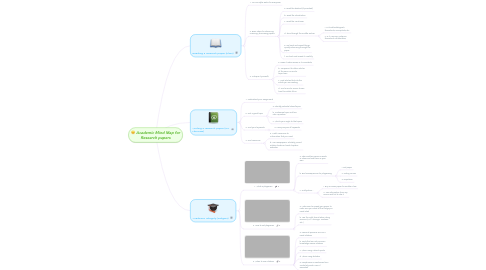
1. Reading a research paper (Klein)
1.1. 1. No one style works for everyone!
1.2. 2. Basic steps for skimming, scanning, processing papers
1.2.1. a. Read the abstract (if provided)
1.2.2. b. Read the introduction
1.2.3. c. Read the conclusion
1.2.4. d. Skim through the middle section
1.2.4.1. I. Is it methodological? theoretical? conceptual? etc.
1.2.4.2. II. Is it a survey? critique? theoretical contribution?
1.2.5. e. Go back and reread things quickly, skimming through the paper
1.2.6. f. Go back and reread it carefully
1.3. 3. Critique it yourself!
1.3.1. a. Does it make sense? is it consistent?
1.3.2. b. Compare it to other articles of the same or similar topic/area
1.3.3. c. Find articles that cite the article you are reading
1.3.4. d. Find a similar source to see how this article fits in.
2. Writing a research paper (UC Libraries)
2.1. 1. Understand your assignment!
2.2. 2. Pick a good topic
2.2.1. a. Identify potential ideas/topics
2.2.2. b. Customize topic and turn into a question
2.2.3. c. What's your angle to the topic?
2.3. 3. Find your keywords
2.3.1. a. Use synonyms of keywords
2.4. 4. Find resources
2.4.1. a. Match resources to information that you need
2.4.2. b. Use newspapers, scholarly journal articles, books or book chapters, websites
3. Academic Integrity (Rutgers)
3.1. 1. What is plagiarism
3.1.1. a. Take another person's words or ideas and use them as your own.
3.1.2. b. Bad consequences for plagiarizing
3.1.2.1. I. Fail paper
3.1.2.2. II. Failing course
3.1.2.3. III. Expulsion
3.1.3. c. Guilty when...
3.1.3.1. I. Buy or reuse paper for another class
3.1.3.2. II. Use information from any source and fail to cite it
3.2. 2. How to not plagiarize
3.2.1. a. Make sure to reread your paper to make sure you cited all the things you need cited
3.2.2. b. Use the right format when citing sources (MLA, Chicago, Turabian, etc.)
3.3. 3. When to use citations
3.3.1. a. Personal opinions DO NOT need citations
3.3.2. b. Facts that are not common knowledge NEED citations
3.3.3. c. When using a direct quote
3.3.4. d. When using statistics
3.3.5. e. Paraphrases or sentences from a scholarly work, even if reworded
